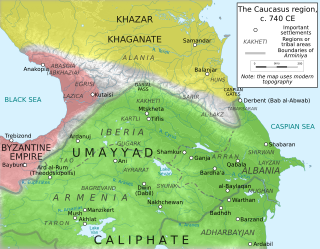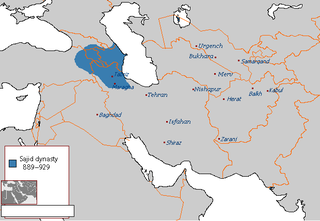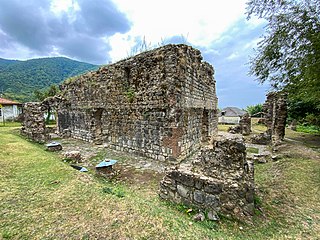
Derbent, formerly romanized as Derbend, is a city in Dagestan, Russia, located on the Caspian Sea. It is the southernmost city in Russia, and it is the second-most important city of Dagestan. Derbent occupies the narrow gateway between the Caspian Sea and the Caucasus Mountains connecting the Eurasian Steppe to the north and the Iranian Plateau to the south; covering an area of 69.63 square kilometres (26.88 sq mi), with a population of roughly 120,000 residents.

The history of Azerbaijan is understood as the history of the region now forming the Republic of Azerbaijan. Topographically, the land is contained by the southern slopes of the Caucasus Mountains in the north, the Caspian Sea in the east, and the Armenian Highlands in the west. In the south, its natural boundaries are less distinct, and here the country merges with the Iranian Plateau.

Sarir or Serir was a medieval Christian state lasting from the 6th or 7th century to the 12th century in the mountainous regions of modern-day Dagestan in southern Russia. Its name is derived from the Arabic word for "throne" and refers to a golden throne that was viewed as a symbol of royal authority.

The Arab–Khazar wars were a series of conflicts fought between the Khazar Khaganate and successive Arab caliphates in the Caucasus region from c. 642 to 799. Smaller native principalities were also involved in the conflict as vassals of the two empires. Historians usually distinguish two major periods of conflict, the First Arab–Khazar War and Second Arab–Khazar War ; the wars also involved sporadic raids and isolated clashes from the mid-seventh century to the end of the eighth century.

The Sajid dynasty, was an Iranian Muslim dynasty that ruled from 889/890 until 929. The Sajids ruled Azerbaijan and parts of Armenia first from Maragha and Barda and then from Ardabil. The Sajids originated from the Central Asian province of Ushrusana and were of Iranian (Sogdian) descent. Muhammad ibn Abi'l-Saj Diwdad the son of Diwdad, the first Sajid ruler of Azerbaijan, was appointed as its ruler in 889 or 890. Muhammad's father Abu'l-Saj Devdad had fought under the Ushrusanan prince Afshin Khaydar during the latter's final campaign against the rebel Babak Khorramdin in Azerbaijan, and later served the caliphs. Toward the end of the 9th century, as the central authority of the Abbasid Caliphate weakened, Muhammad was able to form a virtually independent state. Much of the Sajids' energies were spent in attempting to take control of neighboring Armenia. The dynasty ended with the death of Abu'l-Musafir al-Fath in 929.

Barda is a city and the capital of the Barda District in Azerbaijan, located south of Yevlax and on the left bank of the Tartar river. It served as the capital of Caucasian Albania by the end of the 5th-century. Barda became the chief city of the Islamic province of Arran, the classical Caucasian Albania, remaining so until the tenth century.
Movses Kaghankatvatsi, or Movses Daskhurantsi is the reputed author of a tenth-century Classical Armenian historiographical work on Caucasian Albania and eastern provinces of Armenia, known as The History of the Country of Albania.
Lakia is an ancient ethnic region within the state of Dagestan. Its historical capital is Kumukh, one of the ancient cultural and religious centres of Lakia. The people of Lakia are self-designated as Laks and their native language is Lak.

The Gum basilica is a three-aisled, domed Albanian temple of the 6–7th centuries, located in the Gum village of the Gakh district of Azerbaijan. In the scientific literature, the temple is called a basilica,. Has typological similarities with some earlier temples in Armenia and Georgia
Varaz Grigor was the first known Mihranid king of Caucasian Albania from 628 until at least 654. The last holder of the title was Vachagan III.

Syunik was a region of historical Armenia and the ninth province of the Kingdom of Armenia from 189 BC until 428 AD. From the 7th to 9th centuries, it fell under Arab control. In 821, it formed two Armenian principalities: Kingdom of Syunik and principality of Khachen, which around the year 1000 was proclaimed the Kingdom of Artsakh, becoming one of the last medieval eastern Armenian kingdoms and principalities to maintain its autonomy following the Turkic invasions of the 11th to 14th centuries.
In the history of Azerbaijan, the Early Middle Ages lasted from the 3rd to the 11th century. This period in the territories of today's Azerbaijan Republic began with the incorporation of these territories into the Sasanian Persian Empire in the 3rd century AD. Feudalism took shape in Azerbaijan in the Early Middle Ages. The territories of Caucasian Albania became an arena of wars between the Byzantine Empire and the Sassanid Empire. After the Sassanid Empire was felled by the Arab Caliphate, Albania also weakened and was overthrown in 705 AD by the Abbasid Caliphate under the name of Arran. As the control of the Arab Caliphate over the Caucasus region weakened, independent states began to emerge in the territory of Azerbaijan.
Jalal ad-Din Ali ibn Qara Yoluq Osman, or Ali Beg was the sixth bey of the Turkoman tribal federation of the Aq Qoyunlu from 1435 to 1438.
Viro or Viroy was the Catholicos and head of Caucasian Albanian Church in the early 7th century. His full official title was Catholicos of Albania, Lupenia and Chola.
Nerses Bakur was the Catholicos and head of Caucasian Albanian Church in the late 7th and early 8th century.
Shaykh Ali Khan or Shikh Ali Khan was the last khan of Quba before its annexation to Russian Empire.
Surkhay Khan Kun-Butta or erroneously Khanbutai, Khon-Butai, Khomutai was an 18th-century Dagestani military leader as well as last independent Gazikumukh Khan.
Varaz-Trdat II was the last Mihranid king of Caucasian Albania from 800 to 812/822 and the son of the previous ruler Stephanos I.
Surakat I or Suraka was an Avar nutsal (ruler), who ruled in the 11th–13th and the son of previous ruler Saratan.

Chopan ibn Buday or Chopan II was a Kumyk shamkhal (ruler) of Tarki from 1569 to 1588.








